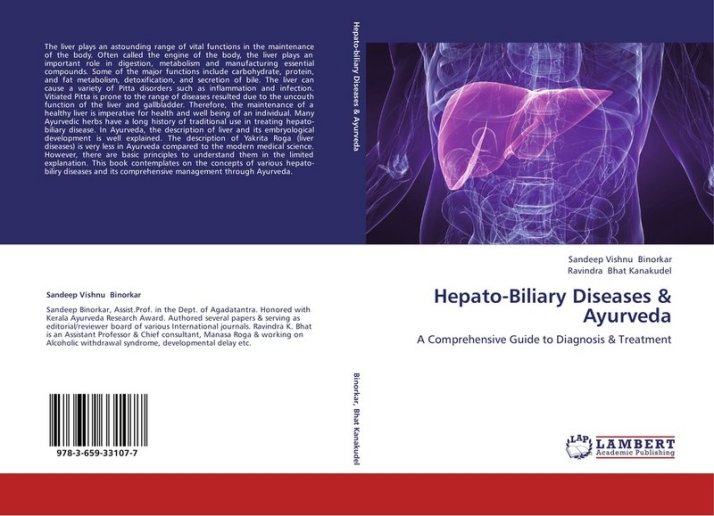THERAPEUTIC AND NUTRITIONAL VALUES OF TAKRA (BUTTERMILK)
Role of Bilwadi Agada in the Management of Scorpion Sting
Hepato-Biliary Diseases & Ayurveda -A Comprehensive Guide to Diagnosis & Treatment
Book Details:
ISBN-13: 978-3-659-33107-7
ISBN-10: 3659331074
EAN: 9783659331077
Book language: English
Number of pages: 128
Published on: 2013-01-29
Available at – https://www.morebooks.de/store/gb/book/hepato-biliary-diseases-ayurveda/isbn/978-3-659-33107-7
************************************************************
Management of Scorpion Stings in Ayurveda
Dear Sir / Madam,
I am extremely delighted to inform you that my first book “Management of Scorpion Stings in Ayurveda” has been published by “LAP Lambert Academic publishing (2012-11-17)” Heinrich – Böcking-Str. 6-8, 66121, Saarbrücken, Germany. I am thankful to all of you for your support. Your valuable comments are highly solicited.
Book Details:
ISBN-13 : 978-3-659-30372-2
ISBN-10 : 3659303720
EAN : 9783659303722
Number of pages : 280
Published on:2012-11-17
For Details – https://www.morebooks.de/store/gb/book/management-of-scorpion-stings-in-ayurveda/isbn/978-3-659-30372-2
PROFILE OF MEDICINAL PLANTS WITH ANTI-OPHIDIAN PROPERTY
New Paradigms in Toxicology
Ayurvedamrutam 1[2]:2012
CENTRAL COUNCIL OF INDIAN MEDICINE
QR Code of www.agadatantra.wordpress.com
Spatula DD – Traditional Medicinal Usage of Tobacco– A Review
IJYAS – Call For Papers
International Journal of Young Ayurveda Scientists (IJYAS)
No permission to Ayurvedic doctors in UP to practice Allopathy
Lucknow: Uttar Pradesh government on Tuesday ruled out giving permission to Ayurvedic doctors to practice allopathy and give medicines and treatment to patients like MBBS doctors. “The government cannot allow Bachelor of Ayurvedic Medicine and Surgery (BAMS) doctors to do the work of MBBS doctors and provide allopathic treatment. It’s not possible… If such a thing is done, there will be no need for MBBS studies,” Parliamentary Affairs Minister Mohammad Azam Khan said in the state Assembly. He was replying to an adjournment notice given by some Congress members who asked the government to grant permission to BAMS doctors to provide allopathic treatment like MBBS doctors. Khan, however, said the government could consider the matter if associations of BAMS and MBBS doctors arrived at any conclusion on this issue and informed the authorities.
Herbal Medicines in Scorpion Sting
Full Article Link – http://www.scribd.com/doc/95985345/AJPTR-Article-Sandeep-Binorkar-5345
GUJARAT AYURVEDA UNIVERSITY, Jamnagar
THE GAZETTE OF INDIA – AYURVEDA AMENDMENT
CCIM NOTIFICATION
Priest with a healing touch against Venoms
KANNUR: He is not a physician by profession and should have devoted his life preaching. But Father Augustine, a Syrian Catholic priest from Mandya in Karnataka, believes in action. Using Ayurvedic medicines, the 58-year-old priest treats snakebites at his Christalaya Visha Chikitsalaya. “Though the modern medicine is apprehensive about Ayurvedic treatment for snakebites, I believe it is more effective and holistic,” said the priest who was in Kannur to attend Vasukiyam 2012, a national seminar on snakebites and its treatment last week.
The priest claims to have cured over 10,000 patients in the last 20 years with no cases of death.
It was in 1982 that he was posted as a priest in Karnataka by MST (Missionary Society of St Thomas the Apostle. He reached Hadanur in Mandya in 1984., where the MST was also running a clinic.
“In 1991, I noticed that there were many cases of snakebites in the locality. In Mandya there are different types of poisonous snakes. People have many superstitions and beliefs about snakebites,” said Fr Augustine.
Born in Kadanad near Pala, his mother Mariyakutty was a traditional healer of snakebites. “She had taught me some methods, and I decided to use my training. That’s how I started the Christalaya Visha Chikitsalaya,” he said.
Augustine is so confident about his methods that he doubts the WHO’s opinion that making incisions and binding with tourniquet is not correct. “Though WHO is against this, my experience is that incision and tourniquet helps controlling the spread of the poison in body. A major portion of the poison will go when the wound is washed after making an incision,” he says.
Unlike modern medicine, in Ayurveda there are different treatment for different types of snakebites, says Fr Augustine. “From the symptoms of a patient and also the local symptoms near the snakebite wound, we can understand the nature of snakebite and the type of snake so that we can give proper treatment,” he said.
He said that the follow-up treatments are also more effective in Ayurveda. Augustine believes that modern medicine should be integrated for effective snakebite treatment in India.
From his experience, he also says that the intensity of the snakebite varies depending on high and low tide that occurs due to the gravitational interaction between the Earth and the Moon. “Also, immediately after monsoon, the possibility of snakebite is more,” says the priest.
AYURVEDAMRITAM – News Letter
AYURVEDAMRITAM
Contemporary Health & Ayurveda Research Updates- News Letter
Published by
Govindbhai Jorabhai Patel Institute of Ayurvedic Studies and Research
New Vallabh Vidyanagar, Anand – 388121 (Gujarat)





